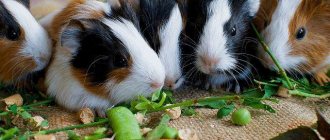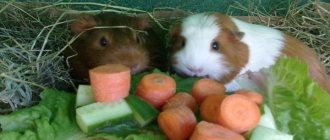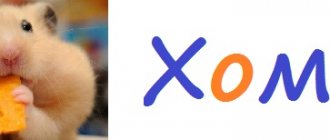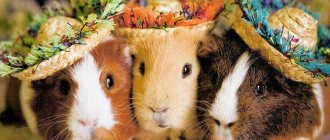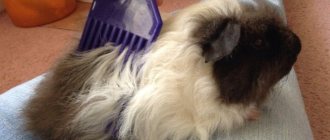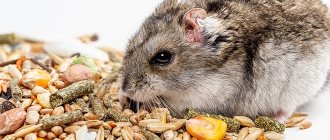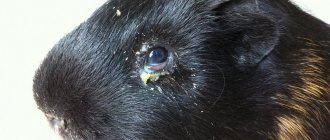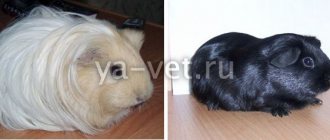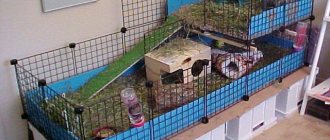- home
- Guinea pig
- Guinea pig nutrition
05/10/2019 When choosing food to create a balanced diet for a guinea pig, owners try to find all the information about the product. The permissibility of potatoes is in question. To determine whether it is advisable to feed your pet this product, you need to know its pros and cons.
Cons of vegetables
Many experts do not recommend feeding your guinea pig raw potatoes due to the large amount of starch they contain. The animal's body does not absorb it well. An excess of this carbohydrate leads to disruption of the gastrointestinal tract. Pathogenic microorganisms multiply in the digestive organs. A small amount of starch is necessary for rodents as an excellent means of replenishing energy. However, a slight excess of the norm leads to obesity, chronic diarrhea and hepatitis. It can also cause liver overgrowth and cirrhosis. Due to the content of complex nitrogen-free organic compounds in potatoes, the pet’s immunity is reduced.
Article on the topic: Can guinea pigs eat tangerines, oranges and lemons?
The benefits of vegetables in the diet
A proper diet for a guinea pig includes foods rich in vitamins and microelements. Grain feed does not contain enough of these components, so additional nutrition consisting of fresh vegetables is required.
The daily requirement of vitamin C for guinea pigs is from 10 mg to 20 mg. The microelement helps improve the immune system and normalize the functioning of organs of all systems. An adult requires no more than 15 mg, a pregnant and lactating female - 20 mg. An excess of vitamin C leads to the development of dermatological diseases and kidney dysfunction.
Vegetables are a source of calcium and phosphorus, which are necessary for the normal development of your pet. However, exceeding the permissible level of indicators leads to the formation of urolithiasis.
Final Recommendations
The final decision on whether to include potatoes in a rodent’s diet is made by its owner. You cannot feed your animal green or sprouted tubers. Raw potatoes are first given in small quantities. When the pet eats a piece, the owner will need to monitor his reaction. If the animal’s health does not worsen within a few days after taking it, then potatoes can be added to the menu. The amount of product consumed should not exceed 20% of the total food. It is recommended to mix potato chunks with other solid foods. Elderly individuals should be fed boiled vegetables, softened with a fork until pureed. Old guinea pigs' teeth are not suitable for raw tubers.
Guinea pigs can be fed almost any fruit and vegetable. Despite this, there are some restrictions. They mainly concern products containing large amounts of starch.
Feed or natural food?
The owners of these cute animals not only need to understand healthy and harmful foods, but it is important for them to know how to organize a proper and balanced diet. They get all their vitamins and minerals from food, so the first thing you need to remember is that your diet should be varied.
They get all their vitamins and minerals from food, so the first thing to remember is that their diet should be varied.
It is recommended to adhere to the following nutrition plan:
- Dry food – 10%.
- Juicy feed – 30%.
- Hay – 60%.
This is what the daily menu should look like. In the case when dry food is not given to a guinea pig, it is replaced with vegetables. Experienced breeders recommend giving 3 types of vegetables and herbs daily. Fruits and vegetables will also be useful, but not all of them and only in small quantities.
Hay is an essential part of the diet. It helps grind teeth down
In addition, hay normalizes digestion processes, which is very important for a guinea pig. The rodent must have access to this product at all times.
Give the rest of the food in 3 doses.
Cons of vegetables
The main disadvantage, the reason why many do not recommend giving raw potatoes to guinea pigs, is the excessive amount of starch. It is almost not absorbed by the animal’s body, as a result of which pathogenic microorganisms begin to multiply in the intestinal tract.
There is no clear opinion among experts whether it is worth including potatoes in a guinea pig’s diet.
Guinea pigs need starch in small quantities to replenish energy, but even a slight excess of the norm leads to:
- animal obesity;
- liver growth;
- chronic diarrhea;
- hepatitis;
- cirrhosis.
Article on the topic: What cereals can be given to guinea pigs
Also, the presence of saponins in vegetables reduces the rodent’s immune defense.
Final Recommendations
The decision on the advisability of introducing potatoes into the pet’s diet remains with the owner. Sprouted or green tubers are strictly excluded.
Raw potatoes should first be offered in microscopic doses. After your pet has eaten a piece, you need to closely monitor its well-being for several days. If the reaction to the vegetable is normal, then it is possible to increase the amount of potatoes to 20% of the daily menu.
Experts recommend mixing the pieces with other hard vegetables, which allow the animals to wear down their incisors. For older guinea pigs, potatoes should be boiled - their teeth are no longer able to process a raw tuber, even finely chopped ones.
Can pigs and other farm animals eat green potatoes?
When potato tubers are exposed to light, they turn green and increase the production of glycoalkaloids, including solanine. This is a natural defense reaction of the plant to protect the soil-exposed tubers. The green color of potatoes occurs due to the appearance of chlorophyll, which in itself is not dangerous, but greening is an indicator of an increase in the concentration of poisonous solanine in potatoes, which is 50-80% concentrated in the peel and the thin layer directly below it. If in most potato varieties the concentration of solanine is lower than 0.2 mg/g, then in green tubers this figure is up to 1 mg/g, and even more. To remove solanine, potatoes need to be peeled and the “eyes” cut out.
Most often, potato toxicosis occurs in cattle, pigs, and less often in goats, sheep and horses. Their cause may be animals eating low-quality potatoes, potato tops and potato stillage.
Green potatoes and sprouted potatoes may be fed to animals only after peeling or boiling for an hour. The water in which unpeeled potatoes were cooked must be drained.
Raw and boiled potatoes as food for guinea pigs, hamsters and livestock
Pet lovers try to diversify the diet of their pets. However, it happens that such care leads to sad consequences. Small pet rodents are at high risk of food poisoning. Often children try to feed them what they eat themselves. Adults also like to experiment - and not always successfully.
Potatoes are considered a popular and affordable food for animals. In raw and cooked form, it is widely used in animal husbandry. Many guinea pigs and hamsters love the vegetable in any form. But it is not suitable for everyone due to the physiological characteristics of the body.
Chemical composition, microelements and characteristics of potatoes
Potato is an annual tuberous plant, food and agricultural crop . Serves as a raw material for the food, chemical, and textile industries.
Depending on the nutritional composition of the tubers, the vegetable is divided into groups:
100 g of product contains 17.5 g of carbohydrates . This represents about 89% of the total energy from the serving.
Calorie content - 77 kcal.
Basic composition in 100 g:
- fats - 0.09 g;
- proteins - 2.05 g;
- carbohydrates - 17.49 g;
- water - 79.25 g;
- ash - 1.11 g.
Article on the topic: Can guinea pigs eat tomatoes and cucumbers? Do they eat them?
The root vegetable contains fat-soluble vitamins - beta-carotene, B and K. Water-soluble vitamins are represented by vitamins C, B1, B2, B3 (PP), B4, B5, B6 and B9.
Contains raw potatoes:
Rose hip
Rosehip is a rich vitamin and mineral complex. It contains vitamins C, E, PP, B1 and B2, minerals - calcium, manganese, potassium, magnesium, sodium, phosphorus, zinc, copper and iron. Guinea pigs can eat berries, flowers and rosehip leaves. Rose hips can be given to your pig fresh or dry, but the fuzzy seeds must be removed before feeding. Rosehip is very useful for a pet, as it strengthens the immune system, improves digestion, calms, restores the animal’s strength after illness or pregnancy, helps against atherosclerosis, with abdominal pain, and with the healing of wounds and cracks in bones. Guinea pigs can also be given rosehip infusion into their drinking bowl.
How suitable are potatoes as animal feed?
Forage varieties are widely used in livestock farming . But not all animals digest this product well.
The leaders in potato consumption among livestock are pigs . Their body absorbs 90% of the protein contained in the tubers. However, we are not talking about raw, but about boiled potatoes. On pig farms, boiled tubers are pounded and mixed feed is added to them in a 4:1 ratio. With this diet, pigs gain weight well.
Cattle are unpretentious and eat potatoes raw . Chopped vegetables are mixed with grain or silage. Artiodactyls eat not only tubers, but also tops and peels left after peeling.
A relatively new type of food, dried potatoes, is approved by livestock farmers . It is nutritious due to its high protein and feed unit content. It weighs 5 times less than raw food, so it is popular for preparing feed mixtures. The dried product is more convenient to store - it takes up less space and has a long shelf life.
Fruits and berries
Bananas
Can guinea pigs have bananas? A banana rich in potassium will benefit your guinea pig, but you should not give more than 1 piece per day.
The peel of the vegetable must be removed, as it is treated with substances hazardous to health (wax, chemicals, ethylene and pesticides). For safety, it is better to remove soft fibers from the fruit.
I'm eating a banana! Om-Nom-nom. I won't give it to you!
Can guinea pigs eat a pear?
Pears can be given with the peel, but without the seeds. The fruit is washed well and cut into pieces; the pig should be offered water along with it. Excessive consumption of pears due to their high sugar content can cause diarrhea.
Can guinea pigs eat kiwi?
Kiwi is a very healthy fruit for animals. It contains a large amount of ascorbic and folic acids. It is also rich in vitamins E, iron, calcium, magnesium and phosphorus.
Kiwi is given without skin in the form of small pieces. For your pet, you need to choose harder fruits. It is better to control the amount you eat. An increase in the dose of kiwi is permissible in autumn and winter, as well as when feeding females during pregnancy and lactation.
Can guinea pigs have oranges and other citrus fruits?
Can be used occasionally. But it is better for guinea pigs to get vitamin C from other foods, avoiding citrus fruits. Possible complications:
- oversaturation with vitamins,
- skin irritation,
- oxidation of urine.
Can guinea pigs eat apples?
Apples can be raw or dried. They have a balanced ratio of sugar and fructose (18:80%). It allows the pig to be active.
The fruit must be peeled and cut into slices. It is better not to give more than 3 pieces at a time.
Can guinea pigs eat strawberries, grapes and other berries?
Strawberries contain a sufficient amount of vitamin C to pay attention to the berry when choosing a treat for a rodent. You can also give strawberry leaves to animals.
- The pig might like grapes. You can offer the animal seedless grapes.
- Eating currants once a week will also not harm your pet.
- If you do not abuse it, you can offer the pig berries and raspberry leaves, berries, leaves and branches of blueberries, blackberries and sea buckthorn, and rose hips without seeds.
- Cranberries are given for medicinal purposes. It has an anti-inflammatory effect on the mucous membranes of the mouth, stomach, and bladder.
Can guinea pigs be given potatoes?
Lovers of decorative pets try to diversify the diet of their pets.
When deciding to feed your guinea pig potatoes, study the composition of the product. Experienced owners are alarmed by the large amount of starch in the vegetable. Therefore, complementary feeding is started with small doses.
Raw
Can guinea pigs eat raw potatoes? Animal owners check this themselves. A small piece of raw tuber is placed along with other usual vegetables . Observe the reaction to the new product. Even if the animal ate it with pleasure, it is not recommended to immediately give a second piece. Monitor your body's reaction during the first 24 hours.
Article on the topic: What grass can be given to guinea pigs: table of allowed plants
For the next 3 days, give one piece at a time, preferably before lunch, to notice possible deviations in digestion. If the pet feels well, then raw potatoes are included in its diet 2-3 times a week.
Boiled
Veterinarians recommend giving boiled tubers to older guinea pigs . Aging individuals find it difficult to chew raw potatoes.
Boiled potatoes are mashed with a fork and added to the food. It is better digested and replenishes the aging body with vitality.
How are potatoes good for hamsters?
In fact, potatoes are a natural food for hamsters. Therefore, domestic rodents are happy to eat pieces of tubers placed in the feeder. Wild hamsters living in natural conditions build huge storerooms underground in which they store supplies for the winter. Potatoes can often be found among a variety of vegetables in burrows. This high-calorie, starchy root vegetable helps wild rodents survive the cold season of the year. Raw tubers contain many substances useful for animals: ascorbic and folic acid, niacin, potassium, calcium, fluorine, B vitamins. Hamsters need all these elements to maintain normal functioning of the body.
Therefore, the question of whether hamsters can eat potatoes should be given a positive answer. Animals that often eat root vegetables almost never suffer from vitamin deficiency, diseases of the circulatory system, or constipation. Raw potatoes improve the functioning of the intestines, stimulate digestion, and reduce the acidity of gastric juice. It is especially recommended to treat pregnant females with the vegetable. Potatoes prevent the occurrence of various pathologies in embryos developing in the womb. It is useful to give the root vegetable to sick animals to improve the physical condition of the body and ease the symptoms of the disease.
Can hamsters be given potatoes?
Veterinarians and pet experts have conflicting opinions on whether hamsters can be given potatoes . It all depends on the individual physiological characteristics of each animal.
If it is well tolerated, there are no digestive system disorders, or signs of deterioration in health, the vegetable is included in the rodent’s diet in small quantities.
Raw
The hamster, as a representative of rodents, eats raw vegetables and fruits in nature . A pet is no exception, so hamsters will benefit from raw potatoes.
If there is a lack of vitamin C, the vegetable helps fight vitamin deficiency, and fast-growing teeth wear down better on raw tubers.
Boiled
It is recommended to include boiled vegetables in the diet of hamsters. They are easier to digest, especially by older individuals .
Attention! The vegetable is boiled without salt.
Boiled vegetables contain a large amount of starch , which leads to excess weight gain. Excess weight has a bad effect on heart function in rodents, and general health worsens. Therefore, this product should not be given daily.
Results
In conclusion, I would like to say that not everything that your guinea pig eats will be good for it. Do not try exotic products on her. If you don’t know whether your guinea pig can eat this or that product, it’s better not to feed it. A rodent in captivity cannot distinguish between products that are not healthy for it and therefore will eat everything you offer. On forums you can often see messages that some owners' guinea pigs eat almost all the foods on the prohibited list. But do not experiment on your pet; give him only vegetables, grass, herbs and fruits growing in our country. Believe me, without oranges, tangerines, bananas, kiwis and other harmful fruits, they will survive and live a long and happy pig life, delighting you.
« Previous entry
Features of fodder potatoes for livestock
Potatoes grown for livestock feed are called fodder potatoes. These varieties are distinguished by an increased amount of protein, but have a less pronounced taste . It has a beneficial effect on the body of animals and increases their productivity.
Forage crops are distinguished:
- high productivity;
- high nutrient content;
- short ripening periods.
Article on the topic: Can guinea pigs eat seeds and nuts?
Fodder tubers are usually 2-3 times larger than table tubers . They often have an irregular shape and taste bland and watery. They get very soft when cooked.
Benefits of fodder tubers:
- high starch content - it is well absorbed;
- high amount of protein - animals grow quickly;
- a complete set of nutrients - other crops that are grown for food do not have such nutritional value;
- high yields.
Flaws:
- during long-term storage, beneficial properties decrease;
- If storage conditions are not met, they turn green and form a toxic substance - solanine.
For long-term storage, silage technology is used - the tubers are acidified with organic acids, which are formed during the fermentation of sugars.
Other products
Can guinea pigs eat bread? It's better not to give.
Can guinea pigs eat nuts and seeds?
Nuts and seeds are among the allowed foods, but can cause obesity if their consumption is not limited. It is better to offer your pet almonds, walnuts or hazelnuts.
The seeds contain many components useful for the animal: fatty acids, calcium, sodium, phosphorus, proteins and vitamins. It is better to give peeled seeds and make sure that they are no more than 15% of the total feed.
Potato damage
If there is a high content of solanine in tubers, there is a risk of intoxication of animals.
The severity of poisoning depends on the amount of potatoes eaten and on the physiological characteristics of the animals.
For guinea pigs
Veterinarians consider the large amount of starch to be the main disadvantage of potatoes.
If your pet has a healthy digestive system and feels good after complementary feeding, they include raw vegetables in their diet, in small quantities and infrequently.
If there is an excess there are consequences:
- obesity;
- liver enlargement;
- chronic diarrhea;
- hepatitis.
For hamsters
strictly forbidden to give raw potatoes to Djungarian hamsters .
The digestive system of this rodent is particularly sensitive. A small amount of solanine in the product will cause intoxication.
Djungarian hamsters are recommended boiled potatoes in moderation in combination with other foods.
For livestock
The tops and tubers of the vegetable are used to feed farm animals
A small amount of solanine is found in potato tops and new potatoes . Its content increases with prolonged and improper storage.
Tubers left in the sun for a long time pose a great danger to livestock. Animals that graze in these fields after harvesting potatoes are at great risk of poisoning.
Article on the topic: Can guinea pigs eat avocado, pineapple, mango and kiwi?
Important! Even the water in which the peels with shoots or greened tubers were boiled is dangerous. Giving animals such a decoction is strictly prohibited.
General recommendations for eating potatoes
Before you treat your pet to a healthy, tasty vegetable, rinse it thoroughly in water and carefully inspect it. If there are green areas or “eyes,” either carefully cut off all the green peel and the solid layer underneath, or simply take another tuber. It should be taken into account that solanine accumulates in the peel and under it during long-term storage, so if the vegetables have been lying around for several months, feed the baby the core of the tuber.
It is best to use vegetables that you grow yourself to feed your pet, so as not to expose the animal to the danger of being poisoned by chemicals. If you are not sure that the vegetables do not contain hazardous substances, cut them into pieces and soak in clean water for several hours. Under no circumstances should you treat your rodent to fried tubers. This food is not at all suitable for the animal, because it contains salt and a lot of fat.
Previous Nutrition for hamstersCan hamsters have carrots: benefits and dangers for Djungarian and Syrian breeds Next Nutrition for hamstersCan hamsters have apples: Djungarian, Syrian, Campbell and other breeds

